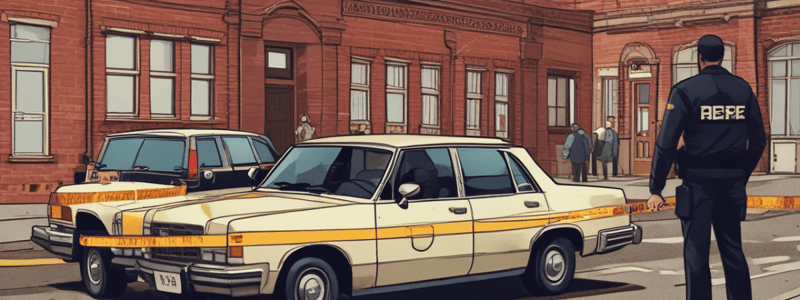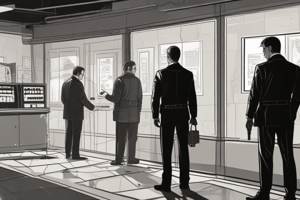Podcast
Questions and Answers
What is the primary objective of the first deputies at a major crime scene?
What is the primary objective of the first deputies at a major crime scene?
- To apprehend the suspect
- To detain witnesses
- To aid the injured and request needed assistance (correct)
- To protect the crime scene
Who is in charge of the crime scene until relieved by a supervisor?
Who is in charge of the crime scene until relieved by a supervisor?
- The supervisor on duty
- The first deputy to respond (correct)
- The deputy with the most experience
- The Crime Scene technician
What is established immediately outside the crime scene?
What is established immediately outside the crime scene?
- A secure perimeter
- A command center
- An entry control point (correct)
- A media briefing area
Who decides if a Crime Scene technician is needed?
Who decides if a Crime Scene technician is needed?
What is the purpose of the Crime Scene Log?
What is the purpose of the Crime Scene Log?
What happens when supervisors must leave the scene?
What happens when supervisors must leave the scene?
Who stays at the scene to brief the Crime Scene technician?
Who stays at the scene to brief the Crime Scene technician?
Why is it important to follow crime scene procedures?
Why is it important to follow crime scene procedures?
What type of deaths do Crime Scene technicians respond to?
What type of deaths do Crime Scene technicians respond to?
Who can request a Crime Scene technician to respond?
Who can request a Crime Scene technician to respond?
What is the responsibility of patrol deputies at routine crime scenes?
What is the responsibility of patrol deputies at routine crime scenes?
What type of crime scenes require highly technical processing beyond the patrol deputy's ability?
What type of crime scenes require highly technical processing beyond the patrol deputy's ability?
Where are physical evidence and elimination prints submitted after collection?
Where are physical evidence and elimination prints submitted after collection?
What type of batteries do Crime Scene technicians respond to?
What type of batteries do Crime Scene technicians respond to?
Who approves requests for Crime Scene technicians made by field command staff or other supervisors?
Who approves requests for Crime Scene technicians made by field command staff or other supervisors?
What type of crimes do Crime Scene technicians respond to with a crime scene?
What type of crimes do Crime Scene technicians respond to with a crime scene?
What is the primary responsibility of Crime Scene Investigative Aides?
What is the primary responsibility of Crime Scene Investigative Aides?
What type of evidence will Crime Scene Investigative Aides collect?
What type of evidence will Crime Scene Investigative Aides collect?
What is the purpose of elimination prints?
What is the purpose of elimination prints?
What type of crimes are typically processed by Crime Scene Investigative Aides?
What type of crimes are typically processed by Crime Scene Investigative Aides?
What is the minimum number of hours of specialized training required for Crime Scene Investigative Aides?
What is the minimum number of hours of specialized training required for Crime Scene Investigative Aides?
What is the purpose of transporting evidence to the Crime Lab or Evidence Control?
What is the purpose of transporting evidence to the Crime Lab or Evidence Control?
Who is responsible for processing routine crime scenes that are the responsibility of patrol deputies?
Who is responsible for processing routine crime scenes that are the responsibility of patrol deputies?
What type of report will Crime Scene Investigative Aides prepare?
What type of report will Crime Scene Investigative Aides prepare?
What is the primary document that guides the collection and submission of latent print evidence?
What is the primary document that guides the collection and submission of latent print evidence?
Who should be included for elimination prints?
Who should be included for elimination prints?
What must be attached and submitted with the Request for Services Form (CL 15)?
What must be attached and submitted with the Request for Services Form (CL 15)?
When can the Request for Services Form (CL 15) be submitted?
When can the Request for Services Form (CL 15) be submitted?
What type of impressions should be included in elimination prints?
What type of impressions should be included in elimination prints?
Why are elimination prints obtained?
Why are elimination prints obtained?
In what type of cases should elimination prints be obtained?
In what type of cases should elimination prints be obtained?
Who reviews the Request for Services Form (CL 15) and the submitted latent lifts/photos?
Who reviews the Request for Services Form (CL 15) and the submitted latent lifts/photos?
What must be submitted to the Lab with swabs that meet the criteria for entry into the CODIS database?
What must be submitted to the Lab with swabs that meet the criteria for entry into the CODIS database?
Who approves the submission of specific articles to the Crime Scene Unit for advanced DNA collection techniques?
Who approves the submission of specific articles to the Crime Scene Unit for advanced DNA collection techniques?
What is the purpose of marking the location of fired cartridge casings at a shooting scene?
What is the purpose of marking the location of fired cartridge casings at a shooting scene?
What must deputies wear when marking the location of fired cartridge casings?
What must deputies wear when marking the location of fired cartridge casings?
Why should the marking device not be placed directly over the fired cartridge casing?
Why should the marking device not be placed directly over the fired cartridge casing?
How far away from the actual item of evidence should the marking device be placed?
How far away from the actual item of evidence should the marking device be placed?
What form must be submitted to the Crime Scene Unit with the evidence?
What form must be submitted to the Crime Scene Unit with the evidence?
What happens to the evidence after it is submitted to the Crime Scene Unit?
What happens to the evidence after it is submitted to the Crime Scene Unit?
Flashcards are hidden until you start studying
Study Notes
Crime Scene Procedure
- The success of criminal investigations and subsequent prosecution often depends on the evidence found at the crime scene.
- Identification, collection, processing, and preservation of evidence are of utmost importance.
Initial Response
- The first deputies at a major crime scene will assume initial command and request needed assistance.
- The first deputy to respond will be in charge of the scene until relieved by a supervisor.
- Deputies in charge will:
- Aid the injured.
- Apprehend the suspect.
- Protect the crime scene.
- Detain witnesses.
- Establish a secure perimeter.
- Protect the scene.
- Establish an entry control point and record the name, agency, and reason for entry, and time in and out of any person entering the scene.
Requesting Crime Scene Technician
- Supervisors will respond to the scene and decide if a Crime Scene technician is needed.
- Crime Scene technicians are available 24 hours a day, seven days a week.
- Technicians respond to:
- Homicides, suicides, accidental deaths, and suspicious unattended deaths.
- Shootings involving deputies.
- Sexual batteries with a crime scene.
- Bank robberies with a crime scene.
- Aggravated batteries with a crime scene and injuries.
- Unusual crime scenes requiring highly technical processing.
- Kidnappings with a crime scene.
- Requests by field command staff or other supervisor-level staff.
Crime Scene Processing
- Routine crime scenes are the responsibility of patrol deputies who will:
- Identify the incident's location.
- Process the crime scene for latent fingerprints.
- Collect any physical evidence.
- Submit physical evidence to Crime Scene, Crime Lab, or Evidence Control.
- Take elimination fingerprints, palmprints, and footprints as needed.
- Transport evidence to Crime Lab or Evidence Control.
- Prepare needed written reports and documentation.
- Routine crime scenes include:
- Burglaries.
- Auto thefts/recovery.
- Vandalism.
- Aggravated assaults.
- Armed robberies with no injuries.
- Deaths when the attending doctor signs the death certificate.
Crime Scene Investigative Aides (CSIA)
- Crime Scene Investigative Aides are specially trained Community Service Aides (CSAs) with 40 hours of specialized training in crime scene processing.
- CSIA have the capability to process routine crime scenes.
- CSIA will generally process only crime scenes involving property crimes.
- CSIA will:
- Process the crime scene for latent fingerprints and serological evidence.
- Collect any physical evidence.
- Take elimination prints and DNA standards if appropriate.
- Prepare needed written reports and documentation.
Evidence Submission
- The collection, documentation, packaging, and submission of latent print evidence to the Crime Lab Latent Print Unit must be in accordance with the Evidence Submission Manual.
- Only suspects or eliminations listed on a Request for Services Form (CL 15) will be compared to the latent lifts/photos.
- Request for Services Form (CL 15) can be submitted with the initial latent submission or later on in the investigation.
- Elimination prints will be submitted for victims and persons having regular access to the crime scene.
- Elimination prints must include fully-rolled fingerprint impressions, palm prints, and when applicable footprint impressions.
- Elimination prints should be obtained in every case where latent prints have been lifted and will be submitted to the Crime Lab.
Marking the Location of Fired Cartridge Casings
- Deputies shall mark the location of each casing for documentation purposes.
- Deputies can use evidence markers, case cards, or any other easily identifiable item for marking the location of each casing.
- Deputies must wear a facial covering and gloves when placing the marking device for each casing.
- The marking device must NOT be placed directly over the fired cartridge casing to avoid any potential DNA contamination.
Studying That Suits You
Use AI to generate personalized quizzes and flashcards to suit your learning preferences.




